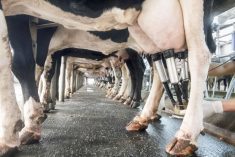The quality of Canadian beef is improving, says an industry audit released June 18.
The national beef quality audit sponsored by the Canadian Cattlemen’s Association examined 35,000 carcasses, representing one percent of Canadian slaughter. There were fewer defects like bruises, mud, brands, injection site wounds and damage from horns but more condemned livers compared to 1999.
These kinds of defects cost the industry more than $9 million.
Injuries from bruises and injections must be cut away. About one-third of the cattle had some form of bruising, mostly in the loin area. In 1999, more than half were bruised. Anywhere from one to three pounds must be trimmed away, costing the industry $6.7 million.
Read Also

Canadian agriculture’s asks from the 2025 federal budget
a preview of the expectations and priorities of Canadian agriculture groups ahead of the 2025 federal budget, set to be revealed Nov. 4.
Quality grades improved considerably while lean meat yields were about the same as before.
The report found 1.2 percent achieved Prime, 52 percent graded were AAA, 43 percent were AA and slightly less than three percent were A. The last audit had almost no Prime grades, while about a third made AAA and 55 percent were AA and 10 percent were A.
Carcass weights are also much heavier. Packers want carcasses between 600 and 925 pounds and the majority met that target. However, the average weight for 2010-11 was 846 lb. for steers and 778 lb. for heifers.
The first audit was conducted in 1995 with the intention to repeat the survey every five years. However, BSE in 2003 halted the work because of a lack of resources, said a news release from the Canadian Cattlemen’s Association.














